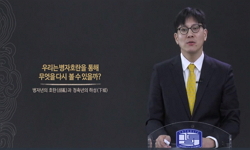The leadership of Korean mothers has rarely been a subject for research. This treatise is part of an observation made in an effort to seek mother leaderships displayed in Korean history. There were three women who served as regents in the era of the t...
http://chineseinput.net/에서 pinyin(병음)방식으로 중국어를 변환할 수 있습니다.
변환된 중국어를 복사하여 사용하시면 됩니다.
- 中文 을 입력하시려면 zhongwen을 입력하시고 space를누르시면됩니다.
- 北京 을 입력하시려면 beijing을 입력하시고 space를 누르시면 됩니다.
https://www.riss.kr/link?id=A76518166
-
저자
한희숙 (숙명여자대학교 인문학부)
- 발행기관
- 학술지명
- 권호사항
-
발행연도
2007
-
작성언어
Korean
-
주제어
어머니 리더십 ; 삼국시대 ; 조선시대 ; 섭정 ; 수렴청정 ; Mother leadership ; Regents ; the era of the three kingdoms ; the Chosun Dynasty ; Suryumcheongjung
-
KDC
300
-
자료형태
학술저널
-
수록면
63-88(26쪽)
- 제공처
- 소장기관
-
0
상세조회 -
0
다운로드
부가정보
다국어 초록 (Multilingual Abstract)
The leadership of Korean mothers has rarely been a subject for research. This treatise is part of an observation made in an effort to seek mother leaderships displayed in Korean history. There were three women who served as regents in the era of the three kingdoms. They were the mothers of Goguryeo's King Taejo, and Shinra's King Jinheung and King Hyegong. Regencies can be seen as a realization of leadership based on motherly rights and maternity, which enabled the kings'mothers to officially participate in politics. These women contributed greatly in the development of their countries by leading their young sons to become fine kings. However, as the Confucian way spread in the society and patriarchy strengthened, the ideal image of a mother changed into a small and passive one. While women's leadership no longer had ground to stand on, their leadership as a mother became relatively stronger, as an absolute figure over their children. Suryumcheongjung of the Chosun Dynasty was a model case in which the mother's leadership shone brightly. There were five queens who successfully defended the sovereignty through Suryum cheongjung. They were Queen Jeunghui(Lady Yun), Queen Munjeong(Lady Yun), Queen Jeungsoon(Lady Kim), Queen Soonwon(Lady Kim), and Queen Shinjeung(Lady Cho). These women displayed fine leadership as the CEO of a nation and endeavored to provide a good background for their young sons to reign wisely. The Suryumcheongjung of the Queen Mothers was a system that effectively prevented the risk of usurps, through the harmonious, caring, and serving leadership of the most senior member of the royal family. Mothers who displayed leadership managed their children's dreams, and effectively acted as a guardian who precisely identified opportunities and threats. They all showed a role model as a mother who was never discouraged in their pursuit of raising their children into great men. However, we fail to find any trace of mother leaderships displayed for their daughters. Therefore, the remaining task will be to display mother leaderships in establishing a society of gender equality where there is no sexual discrimination.
국문 초록 (Abstract)
지금까지 한국 역사 속에서 어머니들이 보여주었던 리더십에 대한 연구는 거의 이루어지지 않았다. 본고는 섭정을 통해 어린 왕을 보호하며 국정을 이끌어간 여성들을 중심으로 그들의 리...
지금까지 한국 역사 속에서 어머니들이 보여주었던 리더십에 대한 연구는 거의 이루어지지 않았다. 본고는 섭정을 통해 어린 왕을 보호하며 국정을 이끌어간 여성들을 중심으로 그들의 리더십을 고찰해 본 것이다. 섭정과 수렴청정은 모두 어린 왕이 즉위하였을 때 왕권이 불안정해질 것을 염려하여 왕실의 최고 지위를 가진 여성, 즉 왕의 어머니나 할머니가 대신 국정을 운영하는 것을 말한다. 여기에 나타난 어머니 리더십의 특징은 다음과 같다. 첫째, 섭정에 나타난 어머니 리더십은 어린 왕에 대한 가장 안전한 보호 장치역할을 하는 것이었다. 둘째, 섭정에 나타난 어머니 리더십은 강한 모성과 모권에 기반을 두고 있었다. 삼국시대에 어린 아들을 도와 섭정을 한 여성은 3명으로 고구려 태조왕, 신라 진흥왕, 혜공왕의 어머니가 그들이다. 이들은 어린 아들이 훌륭한 왕이 되도록 이끌어 국가를 발전시키는데 크게 기여하였다. 셋째, 섭정에 나타난 어머니 리더십은 포용력과 배려 · 섬김의 자세를 바탕으로 하고 있다. 태후의 섭정을 통한 정치 참여는 가족 안에서의 자녀에 대한 어머니 리더십을 보여주는 증거일 뿐만 아니라 국가를 운영하는데 있어 포용과 배려 · 섬김으로 이끌어가는 어머니 리더십을 보여준 것이었다. 넷째, 섭정에 나타난 어머니 리더십은 매우 적극적인 것이었다. 일반적으로 여성이 정치에 있어 매우 소극적이라는 인식을 벗어나 어머니로서 섭정을 할 경우 공식적 비공식적인 정치참여를 통해 적극적으로 정국운영을 주도해 왔다. 조선시대에 어린 왕을 도와 수렴청정을 한 5대비는 여성임에도 불구하고 국가 최고경영자의 자리에 앉아서 자신이 할 수 있는 최대한의 리더십을 발휘하여 어린 왕이 국가를 잘 경영해 나갈 수 있도록 보호하였다. 대비들의 수렴청정은 조화와 배려, 섬김의 리더십으로 왕위찬탈의 위험을 미리 예방하면서 조선왕조 500년의 왕위를 계속 이어갈 수 있도록 한 디딤돌이었다. 다섯째, 섭정에 나타난 어머니 리더십은 성리학의 심화 과정에서 점차 소극적으로 변화되어 갔다. 성리학적 지배질서가 심화되고 가부장권이 강화되면서 친정식구나 대원군에게 국정운영을 맡기는 면이 나타났으나 어머니로서 자식을 보호하고 국정을 안정적으로 이끌어 나가야 한다는 기본에는 변함이 없었다.
동일학술지(권/호) 다른 논문
-
- 숙명여자대학교숙명리더십개발원
- 양동숙
- 2007
-
- 숙명여자대학교숙명리더십개발원
- 조병남
- 2007
-
- 숙명여자대학교숙명리더십개발원
- 하은혜
- 2007
-
한국형 리더십 과정 개발과 적용 및 성과에 관한 실증적 연구
- 숙명여자대학교숙명리더십개발원
- 문형남
- 2007




 RISS
RISS







